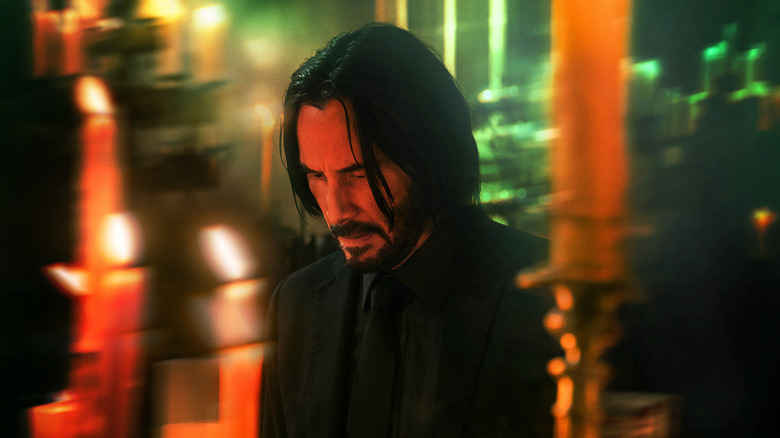
The following post contains spoilers for "John Wick: Chapter 4."
This was my dad's favorite story: One morning, when I was four years old, a jingling chain and a loud thump woke me. I crept downstairs to investigate and found my dad -- drenched in sweat -- punching a leather hanging bag. Without hesitating, I said, "I want to do that, too." Although it surprised him, he replied, "Alrighty, kiddo." He enrolled me in karate that week. Soon, martial arts became our thing. On Saturdays, we attended regional tournaments in crowded gyms. I competed in sparring, and my dad refereed. Before and after matches, we'd spend hours debating scores, questioning techniques, and musing on the dangers of executing flashy movements amidst incoming kicks.
For over two decades, I've studied martial arts both to honor my dad's memory and because my bones can't remember a time before I did. As a result, nothing brings me more joy than discovering an action film with entertaining, direct, and challenging fight sequences. Compared to real martial arts competitions, fight choreography plays by different rules. If a fighter moves too quickly, audiences can't see what's happening. If they move too slowly, thetense showdowns become predictably campy.
With "John Wick: Chapter 4," director Chad Stahelski raised the bar for hard-hitting martial arts sequences once again. Put the pistols away. To celebrate the Baba Yaga's latest quest, I'm bringing out the scorecards and rating the film's main fights based on four factors: creativity, clarity, fluidity, and power.
Director Chad Stahelski's Holistic Vision For John Wick: Chapter 4
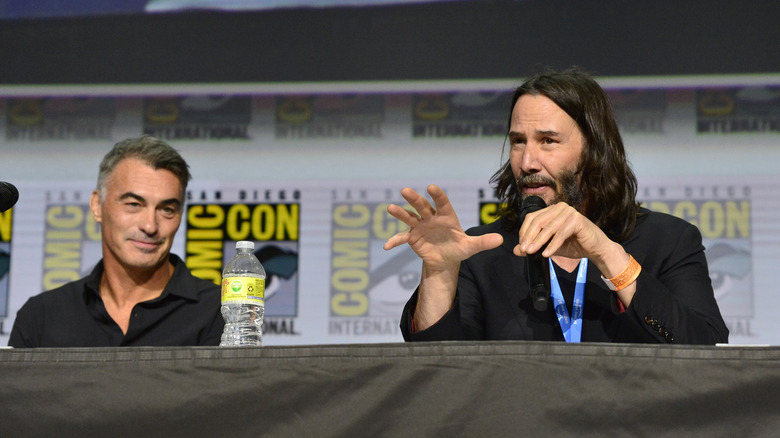
Before I strap my gloves on and jump into the ring, let's first note Stahelski's dedication to well-planned action scenes. The "John Wick: Chapter 4" director has a background in stunt work and second-unit directing, and he meticulously plans fight sequences months in advance with his full crew. As he explained to Deadline, "What good is it for me to spend $5 million on my stunt guys with Keanu training for 10 weeks, and not train the camera guys? Who do you think shoots it?"
As Stahelski noted, most people who make action films don't include the camera crews and local stunt workers in the rehearsal process, ostensibly in an effort to save money. In fact, it's not uncommon for a local stuntperson to arrive at a set on the day of shooting without seeing the fight ahead of time. Most Marvel Cinematic Universe films even pre-budget for reshoots under the assumption that the action sequences will need to be fixed. By contrast, Stahelski makes sure the cast and crew are present for location scouts, training sessions, and logistical planning so that the fight unfolds precisely the first time around, even if it costs a little more up front.
The Effort Shows On Screen
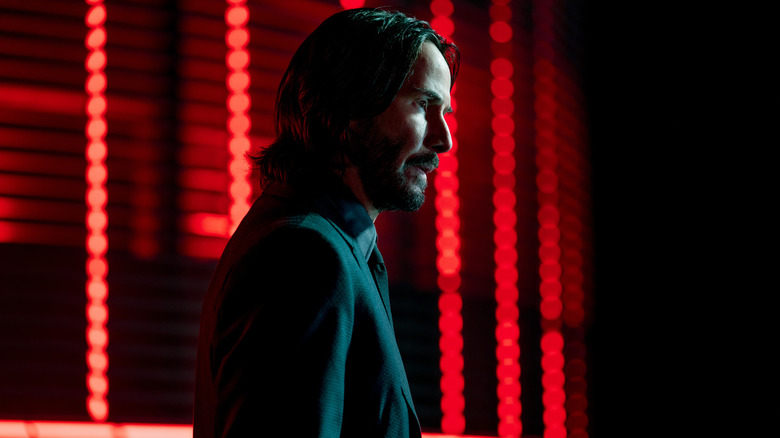
Stahelski told The Hollywood Reporter that "John Wick 4" had over 200 stunt performers. Per Deadline, Scott Rogers served as the film's supervising stunt coordinator, while Jeremy Arenas choreographed it, with assistance from "three other riggers and three other choreographers and two assistant stunt coordinators." Of course, Stahelski stepped in to coordinate some scenes himself, too.
To shed some light onto why this number is so impressive, action films typically credit an average of 46 stunt performers. That number is a lot higher for ensemble-heavy action films set in big cities, like "Avengers: Age of Ultron," but this is still a testament to how many working stunt people Stahelski employed — to great effect, too.
Another director might've shot the film in a way that simply creates the illusion of crowds. Action-heavy series like "The Boys," for example, often digitize shots, copy-and-pasting people into the background to make locations feel more populated. Avoiding wide-panel shots is another way filmmakers hide how small the cast is. But not Stahelski! All of these fights are lovely to watch in their own ways. Even the outlandish ones feel grounded in reality; I'm here to play referee, and determine what the actual outcome of these impeccably choreographed fights would be.
7. Killa Vs. John Wick
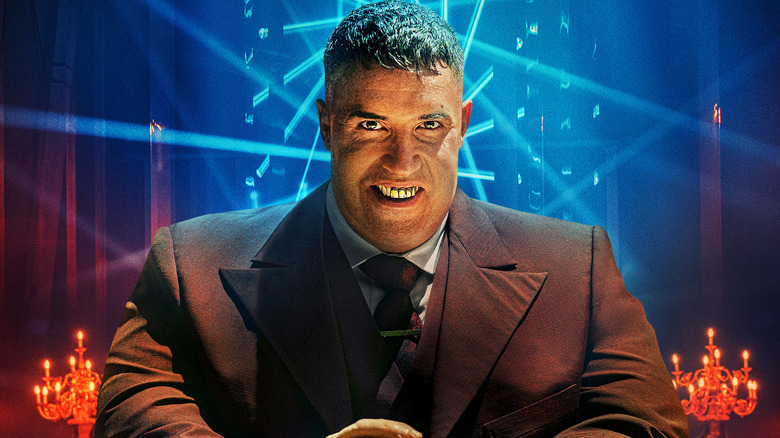
Creativity: 3/5. A tense opening, but a lot of repetitive moves.
Clarity: 5/5. Owned the entire club!
Power: 2/5. Are John Wick's bones made of Adamantium?
Fluidity: 4/5. Killa's spinning kicks!
Diehard fans of martial arts flicks have likely lost count of how many Scott Adkins films they've seen. Although he's studied a wide-range of martial arts, Adkins' Killa mostly mixes taekwon-do high-section kicks with judo throws when facing John Wick (Keanu Reeves). Because of the character's stature, that's not necessarily a bad idea. Taking advantage of his size, Killa easily overpowers John's jiujitsu and judo throws. In video game terms, Killa is a tank: His wider center of gravity gives him an advantage over John. Force alone won't knock Killa over, at least not easily.
Yes, Killa and John's fight is deliciously scrappy. No one else has dragged the Baba Yaga around by the tie! But at one point, Killa does a hopping side kick, sending John into a cement wall. (Let's not even talk about the spinning wheel kick to the head.) In taekwon-do, side kicks -- especially hopping and turning ones -- are dangerous. Your core, hips, and legs essentially push your foot forward with the power of your entire body weight. Ribs will break. While the action here is clearly orchestrated, that kick was a finishing strike. Sorry, John — there's no way you should've walked away from that one!
6. Akira Vs. Chidi
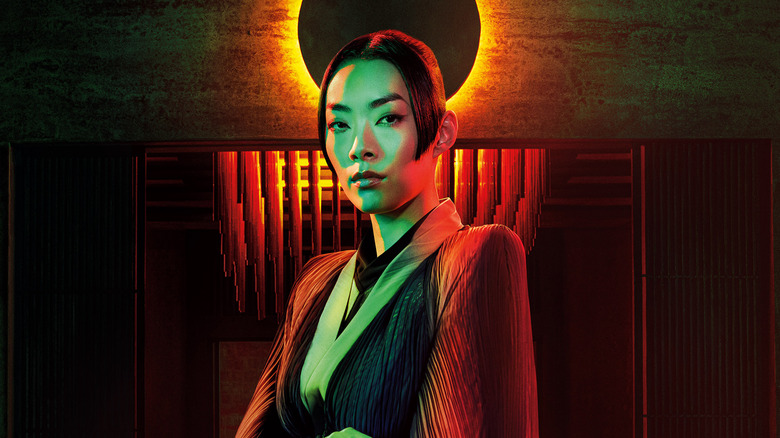
Creativity: 4/5. Using her bow as a block into a knee slide to a judo throw?! Icon.
Clarity: 4/5. Sleek and speedy!
Power: 3/5. Points deducted for more weapon-oriented hits.
Fluidity: 4/5. Did you see that kick into a split move?
Thanks to Rina Sawayama's background in dance and musical performance, Akira's greatest strength is her flexibility. No, she doesn't hit harder than Chidi (Marko Zaror) during their face-off, and there are just a few too many steps between her movements, making her easier to catch. Still, Akira's persistence and gritty tactics (look at that moment she climbs up a body by stabbing it) save her. Unlike the brawler, she changes, surprising others by using her bow as a shield and hook-like weapon.
While fighting Chidi, Akira recognizes the power imbalance and holds her own by using his momentum against him. Can't throw the hulking Chidi across the room with a judo throw? No problem! She'll dip and weave so quickly that she'll tire him out ... eventually. A killer set of knives helps her defeat similarly bulky opponents in Osaka's Continental, too. In reality, some of Chidi's hits should have slowed Akira down more, but her buoyancy is unforgettable.
5. John Vs. An Apartment Building Full Of Baddies
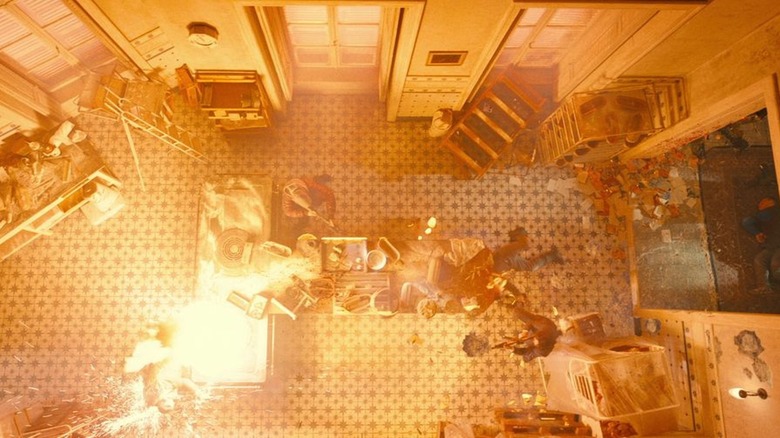
Creativity: 5/5. Might be the best top-down almost oner in film history.
Clarity: 3/5. Action happens very quickly, which is thrilling, it's but overpacked.
Power: 4/5. Some of the film's best hand-to-hand combat occurs amidst the gun-fu.
Fluidity: 5/5.
Technically, this isn't a one-on-one battle with John Wick. However, I can't not include this epic fight on this list; Stahelski basically transforms the building into a character itself. While top-down shots aren't new to action films, I've yet to see another one that spirals out into almost a one-take scene, or "oner," that contains a non-stop cavalcade of fights. As Stahelski told /Film, there are three digital stitches here. However, the editing is so tight that, aside from the cutaway, you'll believe that these are two oners knitted together. Of everything in the "John Wick" films, this sequence in "Chapter 4" feels the most like a loving callback to "The Raid: Redemption," with explosive moments that cascade into several one-on-one battles, including one with Chidi. All that, and a shotgun-turned-quasi-flamethrower!
However, the way the action is shot does have a drawback. Yes, it looks cool as hell, but there's so much going on that the clarity suffers. Additionally, unlike similar scenes in Gareth Evans' film, Stahelski's technique limits the amount of intimate combat you can actually see, particularly when it comes to counterattacks. When it comes to both fighting styles and character development, how someone averts a punch is just as essential as which locks they use.
4. Shimazu Vs. Caine
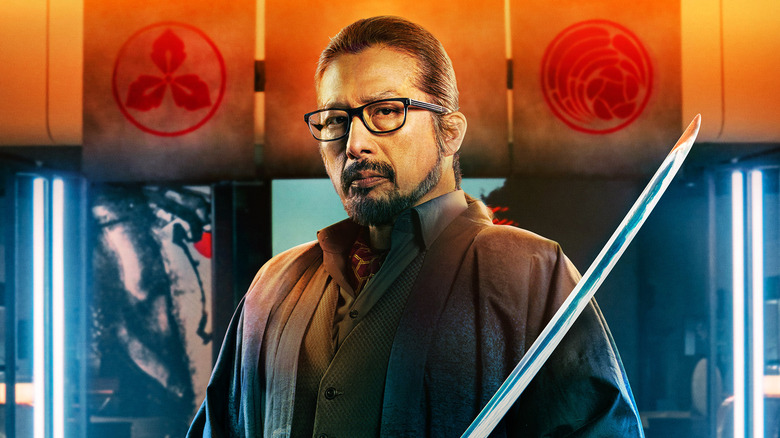
Creativity: 4/5. Technically precise, but par for the course for a short katana duel.
Clarity: 5/5. Spotless form and clear follow through of movement.
Power: 4/5. Katana fights are more about speed and the rotation of the hips.
Fluidity: 5/5. Makes the ballet look clunky!
There are few working actors whose names are as synonymous with samurai movies as Hiroyuki Sanada. Seeing him pop up in the credits almost guarantees that a katana will somehow appear in a film. Trained by the legendary Sonny Chiba, Sanada knows how to translate his skills in kendo, shorinji kempo, and kyokushin kaikan karate into drama. Here, he brings poise, stillness, and a grandiose nature to Shimazu's strikes. Not only are his movements precise, but he prefers to counter rather than outright attack. Like any seasoned fighter, he knows that wasted movement equals wasted energy. When contrasted against Caine's (Donnie Yen) rapid-fire hands, a dialogue emerges between the two men that's punctuated by each strike. It's grippingly beautiful.
My only complaint is that I don't think the katana battle would've ended as quickly as it does. Of course, in the context of the film, it makes sense, but I don't believe that Caine would have escaped without any cuts. The downside to an aggressive offense is that it leaves you more open to a kick — or, in this case, a blade. At the very least, Caine should have walked away with one deep wound.
3. Donnie Vs. Marchese's Henchmen
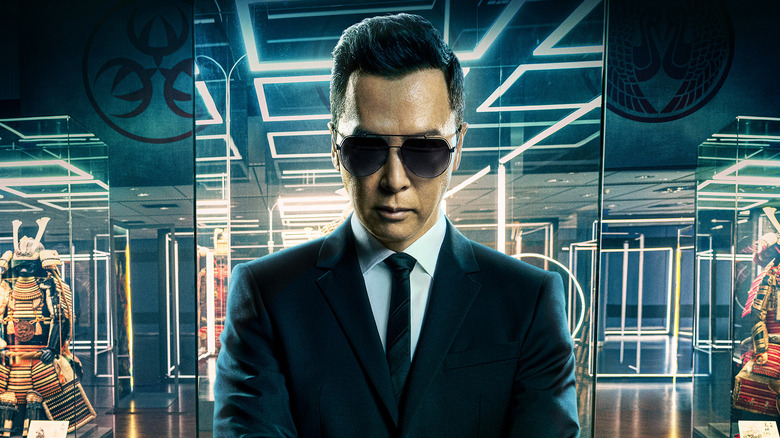
Creativity: 5/5. The bell sounds are ingenious.
Clarity: 4/5. At times, the camera moves away a little too quickly from landing strikes.
Power: 4/5. Caine's style is more about multiple speedy attacks than a single mighty blow.
Fluidity: 5/5. The movements connect seamlessly.
I'm about to kick off the Donnie Yen fandom hour, and I'm not sorry! That the "Ip Man" star became a lead in the "John Wick" franchise is a huge deal. The son of Wushu grandmaster Bow Sim Mark, Yen has had Hollywood knocking on his door for decades, although so far he's primarily played clichéd roles like Îmwe in "Rogue One" — or, as Yen described the part to Prestige, "another stereotypical Chinese martial-arts man." For "John Wick: Chapter 4," however, Yen worked with Stahelski to make his character as cool as Chow Un-fat. As the Los Angeles Times notes, Yen even changed Caine's name in order to "reclaim" it in honor of Bruce Lee, who was famously passed over for the role of Kwai Chang Caine on the '70s series "Kung Fu."
In "John Wick: Chapter 4" Yen gets the entrance of a lifetime, fluidly flipping between high-section kicks, staff blocks, and numerous showcases for the fast hands that have made him a Hong Kong action film icon. He charts out the Osaka Continental by dropping bells that go off with movement. He uses his wrist to locate objects in space, showing how his understanding of the environment trumps trigger-happy fingers. While I'm skeptical about how well he could dodge the Marchese's firing squad, Caine's swagger and deft footwork make me believe he can dance around bullets. And yet, the best is yet to come!
2. John, Caine, And The 222 Steps
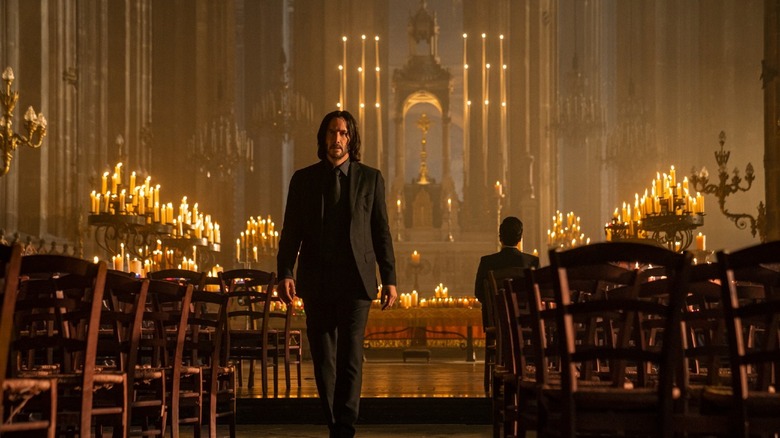
Creativity: 3/5
Clarity: 5/5
Power: 5/5
Fluidity: 5/5
Stahelski and his crew are known for twisting action set pieces into resonant symbolic moments. Yes, watching enemies throw John down 222 steps again and again is a pitch-perfect mix of slapstick comedy and rage fuel for John, but it also showcases what "John Wick: Chapter 4" is all about. When Caine arrives to help John up after he falls for the umpteenth time, the action carries some real narrative power: These friends connect to ensure that, whatever comes next for John Wick, it's honorable.
What follows is an uphill (literally) battle to the finale. Again, Yen shines. Caine is remarkably adept at using weapons, like swords, to block and redirect incoming attacks. (He also gets a callback to "John Wick: Chapter 2" when he uses a pencil as a weapon!) While the enemies waiting in the wings to attack makes it all feel a bit too much like a video game, I'm giving this sequence extra points for how well-lit the shots are. I can see Chidi's gorgeous roundhouse kick to the head as clearly as Caine's hands. Clarity makes action scenes like this one soar. If fights are conversations, then missing a counter-attack is like ignoring a crucial piece of dialogue. The scene only works if you can follow the entire thing.
1. John Vs. Caine At The Osaka Continental
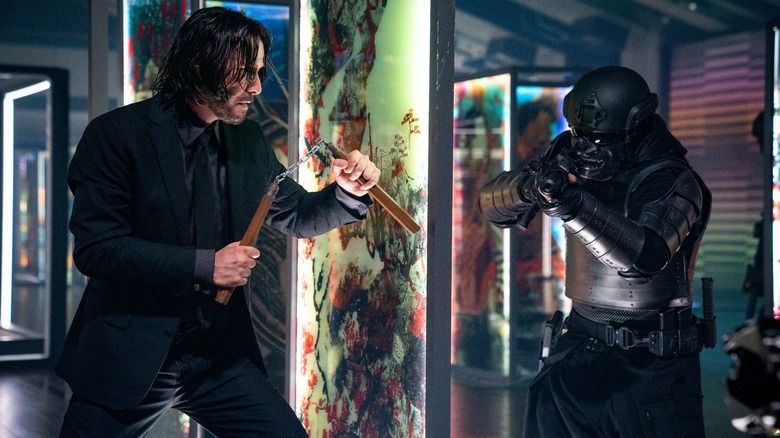
Creativity: 5/5
Clarity: 5/5
Power: 5/5
Fluidity: 5/5
Yes, this scene left me speechless. Yen is known for his triple kicks and fast hands, so watching him fully immerse himself into the slick gun-fu of "John Wick" is a thrill. What elevates Yen and Reeves' fighting is how well they marry their styles. John goes for a grapple, but Caine can escape wrist locks with ease. John might throw a mighty side kick, but Caine knows how to redirect the energy back at John while wielding both a sword and a pistol.
However, Stahelski and his team keep hints of judo in Caine's movements, which makes it feel like the two men have trained together in the past as friends. Caine and John also land some solid elbow and knee strikes that feel real, showing off both fighters' calculated decisions to counter and create distance. The mixture of martial arts styles opens up space for a little bit of everything: intimate strikes, long-range attacks, defensive dodges, and more.
Also, nunchucks have a starring role throughout the Osaka Continental battles! Okay, I chuckled when John stepped out of a fight to do a spin routine, but I was still gleeful when the nunchuck caught and threw a gun away. For me, the weapon was as much a star as these two juggernauts of action cinema. Well done, boys.
Read this next: John Wick Moments That Went Too Far
The post Every Fight in John Wick: Chapter 4, Ranked Worst to Best appeared first on /Film.

